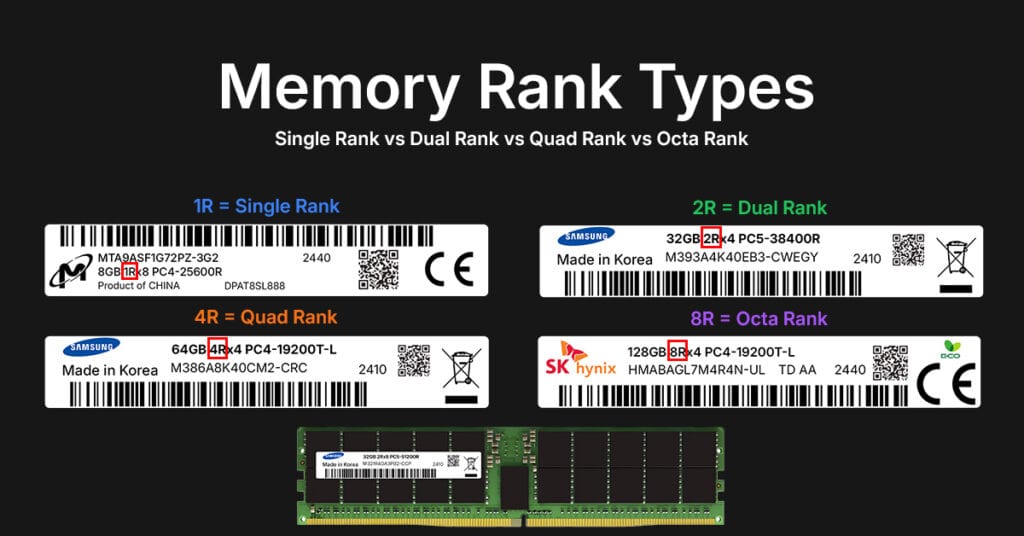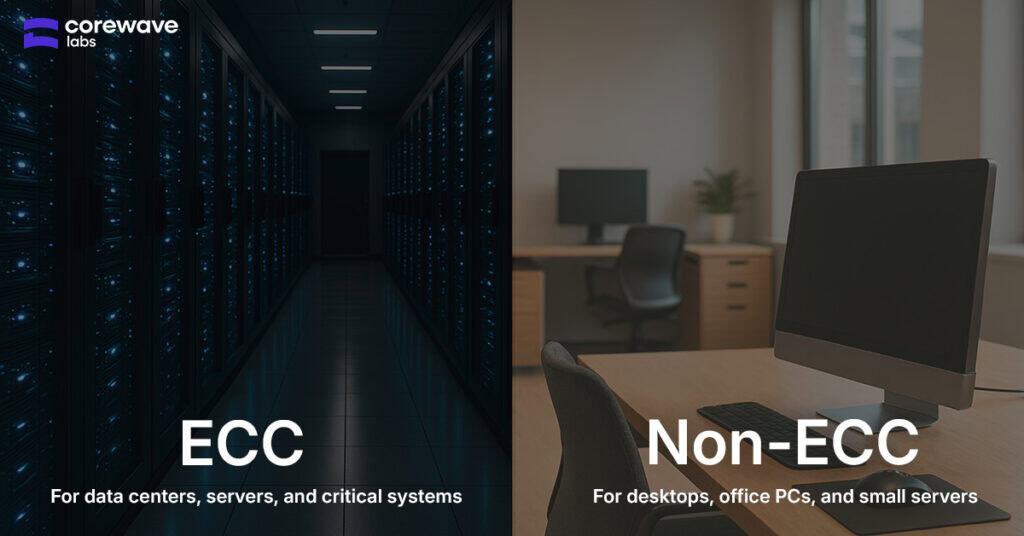Updated on:
| Written by:
DDR3 vs DDR4 vs DDR5: 2025 Datacenter Guide
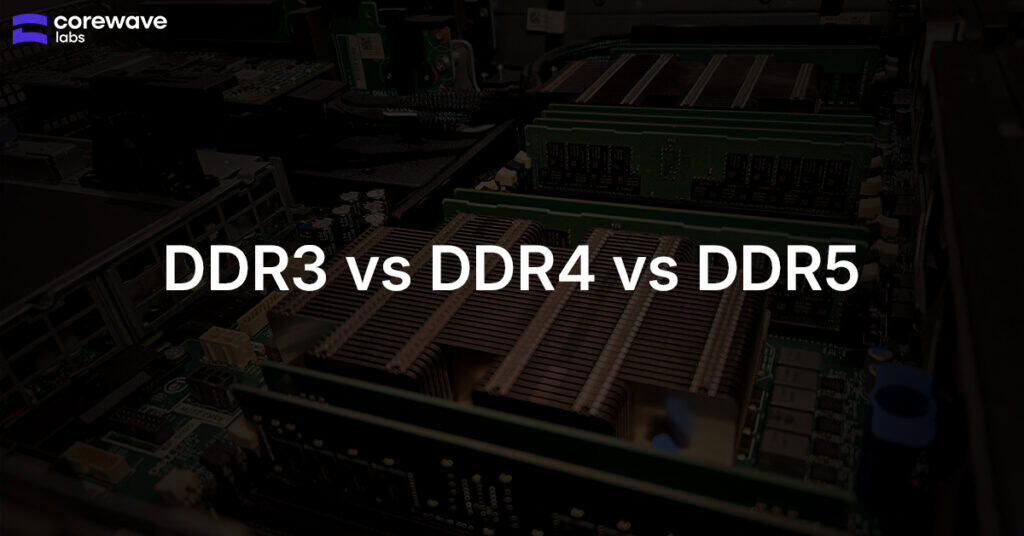
- 1. Introduction
- 2. Release Timeline & Adoption
- 3. Performance Metrics (Latency, Bandwidth, Speed)
- 3. Power Efficiency Trends
- 4. Memory Capacity & Density
- 5. Architecture & Feature Updates
- 6. Market Availability & End-of-Life
- 7. Compatibility & Upgrade Tips
- 8. Frequently Asked Questions (FAQ)
- Conclusion: Which Should You Choose?
Key Takeaways
- DDR3 → Legacy-only; use for maintaining old systems, not for new deployments.
- DDR4 → Today’s standard; balances cost, performance, and compatibility for most enterprise workloads.
- DDR5 → Future-proof upgrade; delivers higher bandwidth, capacity, and power efficiency — ideal for AI/ML, HPC, and data-heavy environments.
- No cross-compatibility → DDR3, DDR4, and DDR5 require matching CPUs and motherboards; you can’t mix generations.
- Strategic move → For long-term scaling, DDR5 is the clear choice despite higher upfront costs.
1. Introduction
Server memory is the heartbeat of modern IT infrastructure. It determines how efficiently data moves between CPUs and processes, shaping the speed, scalability, and resilience of everything from AI workloads to real-time analytics.
With each new generation — DDR3, DDR4, DDR5 — memory has evolved dramatically: boosting power efficiency, bandwidth, latency management, and architectural complexity. But today, selecting the right memory isn’t just about capacity. It’s about balancing total cost of ownership, energy footprint, and platform compatibility for long-term performance.
This guide delivers a detailed DDR3 vs DDR4 vs DDR5 comparison to help you make informed upgrade decisions — directly impacting system throughput, efficiency, and infrastructure longevity.
2. Release Timeline & Adoption
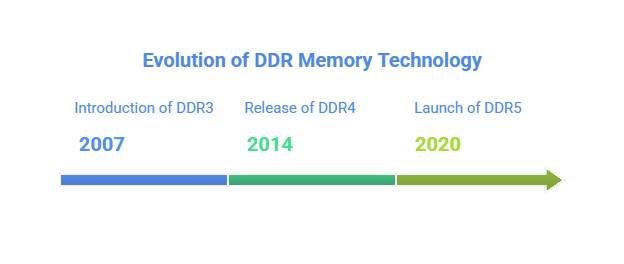
DDR3 – The Legacy Foundation (2007)
Released in 2007, DDR3 delivered major gains over DDR2: higher clock speeds, lower power draw, and broader workload support. It became the backbone of enterprise servers through the 2010s, but is now largely limited to legacy systems where hardware refresh costs or operational risks delay upgrades.
DDR4 – The Enterprise Workhorse (2014)
Launched in 2014, DDR4 set new standards for performance, energy efficiency, and memory density. With speeds up to 3200 MHz and DIMMs scaling to 64 GB, DDR4 became the go-to choice across data centers, telecom cores, and cloud infrastructure. Today, it dominates most production deployments thanks to its balance of cost and capability.
DDR5 – The High-Performance Frontier (2020)
Introduced in 2020, DDR5 targets next-gen workloads demanding high bandwidth, scalability, and advanced power management. Offering up to twice DDR4’s bandwidth, integrated ECC, and on-die voltage regulation, DDR5 is accelerating into AI, HPC, and telco-edge use cases. As pricing normalizes, DDR5 is poised to overtake DDR4 as the new enterprise standard.
3. Performance Metrics (Latency, Bandwidth, Speed)
| Feature | DDR3 | DDR4 | DDR5 |
|---|---|---|---|
| Clock Speed | 800–2133 MHz | 1600–3200 MHz | 4800–8800 MHz |
| Bandwidth | 6.4–17 GB/s | 12.8–25.6 GB/s | 38.4–57.6 GB/s |
| Transfer Rate | 800–2133 MT/s | 1600–3200 MT/s | 4800–7200 MT/s |
| Latency | ~14 ns | ~14 ns | ~14 ns |
What These Numbers Mean in Practice
DDR5: Unlocking High-Throughput Workloads
DDR5’s peak bandwidth — over 57 GB/s per module — delivers a step change in memory throughput. This enables real-time responsiveness and deep parallelism in data-intensive environments such as:
- AI/ML model training at scale
- In-memory databases (SAP HANA, Redis)
- High-performance computing (HPC) clusters
- 5G core network processing and CDN caching
For architects and engineers, this isn’t just a spec-sheet win — it’s a strategic edge: more data moved per second means faster workload execution and higher competitiveness.
Latency: Stable Despite Speed Gains
Even as bandwidth and transfer rates have surged, memory latency has held steady at ~14 nanoseconds across DDR generations. Why? Advanced memory controllers and architectural refinements compensate for increased clock speeds.
For system engineers, this translates to faster data access with no latency penalty — even under extreme throughput loads.
3. Power Efficiency Trends
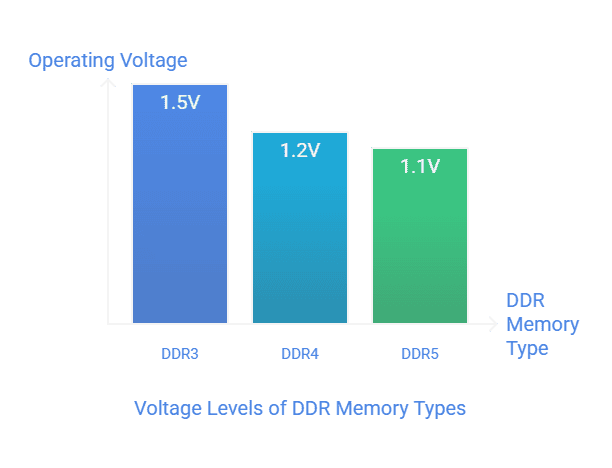
Why Voltage Reduction Matters
Every DDR generation cuts voltage, driving down power use per DIMM. While a single module’s savings seem small, scale that across thousands of DIMMs in a hyperscale data center — and you unlock substantial reductions in total power draw and cooling load.
DDR5’s Efficiency Breakthrough: On-Die Voltage Regulation
Unlike DDR3 and DDR4 (where voltage regulation happens on the motherboard), DDR5 integrates it directly onto the module. This delivers:
- More precise power control
- Simpler motherboard design
- Improved power management in high-density deployments
The result: DDR5 achieves significantly better performance per watt, making it ideal for organizations prioritizing both compute scaling and energy efficiency.
4. Memory Capacity & Density
Maximum DIMM Capacity by Generation
| Memory Generation | Max DIMM Size | Max Die Density |
|---|---|---|
| DDR3 | 16 GB | 4 Gbit |
| DDR4 | 64–256 GB (with 3DS, LRDIMM) | 16–32 Gbit |
| DDR5 | 128–512 GB (and rising) | 64 Gbit + die stacking |
Why Capacity Gains Matter
While DDR3 maxed out at 16 GB DIMMs, DDR4 can push up to 256 GB using advanced LRDIMM and 3DS modules, expanding workload support significantly.
DDR5 takes this further — delivering 128–512 GB per DIMM today, with even higher capacities coming as die stacking and 3D packaging mature.
These density jumps mean fewer installed modules, simpler server designs, and greater total system capacity.
Impact on Scalability
DDR5’s high-capacity modules let you:
- Consolidate more workloads onto fewer servers
- Reduce power and thermal load per rack
- Run data-heavy applications like AI/ML, real-time analytics, and in-memory DBs at scale
For modern IT and edge deployments, DDR5 offers unmatched density, flexibility, and efficiency — pushing beyond what DDR4 can sustainably deliver in next-gen architectures.
5. Architecture & Feature Updates
Server memory hasn’t just evolved in speed and capacity — it’s become smarter and more resilient. Each generation adds architectural gains that improve data integrity, throughput, and energy efficiency, critical for mission‑critical environments.
DDR3 → DDR4: Foundational Enhancements
- Cyclic Redundancy Check (CRC): Detects and corrects transmission errors, boosting reliability.
- Higher Burst Length (BL8): Transfers more data per access cycle, increasing throughput.
- Improved Signal Integrity: Reduces electrical noise, improving stability in high-density deployments.
Together, these made DDR4 not just faster, but more robust — ready for 24/7 enterprise workloads.
DDR4 → DDR5: Next‑Generation Architecture
- Dual-Channel per DIMM: Two independent 32-bit channels per module, doubling effective bandwidth.
- Burst Length 16 (BL16): Doubles data transfer per memory operation, ideal for large sequential workloads.
- Integrated ECC: Built directly into the chip’s core, reducing silent data corruption at the silicon level.
- Decision Feedback Equalization (DFE): Improves I/O signal quality, enabling higher data rates with fewer transmission errors — critical in high-frequency, high-density systems.
These innovations make DDR5 not just a performance upgrade — but a scalable, resilient, power-efficient platform for modern enterprise and hyperscale infrastructure.
6. Market Availability & End-of-Life
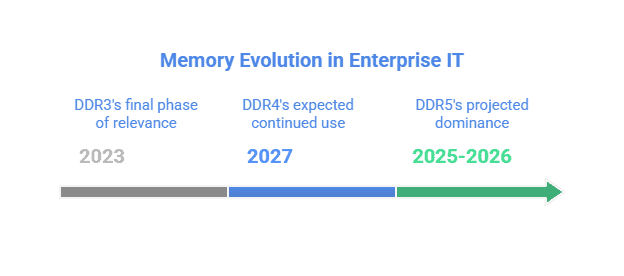
DDR3 — Final Phase (Legacy Only)
Once the datacenter standard, DDR3 is now confined to legacy systems. Manufacturing has largely wound down, prices are less favorable, and compatibility with modern CPUs is effectively gone.
Current Use: Only for maintaining legacy platforms where upgrades are not yet feasible.
DDR4 — Mature, Stable, and Dominant
DDR4 remains the most widely deployed memory in enterprise IT, balancing cost, performance, and platform compatibility. Backed by nearly all major server ecosystems, DDR4 benefits from mature supply chains and competitive pricing.
Outlook: Expected to stay dominant through ~2027, especially in environments with longer refresh cycles or delayed DDR5 transition.
DDR5 — Rapid Growth, Approaching Dominance
Initially premium-priced, DDR5 is now scaling fast as production ramps and OEM adoption increases. Designed for AI, HPC, and high-bandwidth systems, DDR5 offers superior performance-per-watt and throughput.
Forecast: Expected to surpass DDR4 as the new enterprise standard by ~2025–2026, especially in next-generation datacenter and edge deployments.
7. Compatibility & Upgrade Tips
Platform Compatibility: No Mixing Generations
DDR3, DDR4, and DDR5 are electrically, physically, and architecturally incompatible.
Each requires:
- A CPU that explicitly supports the memory generation
- A motherboard with the correct DIMM slots, chipset, and BIOS
You cannot install DDR5 in a DDR4 board — no mainstream server platform allows mixed-generation operation.
Why DDR4 and DDR5 Can’t Coexist
Even on CPUs that support both (like Intel 12th Gen), you must run one or the other. Why?
- Voltage difference: 1.2 V (DDR4) vs 1.1 V (DDR5)
- Different memory controller designs
- Different pin layouts and module keying
- Unique BIOS and firmware tuning per generation
Planning Your Upgrade
When evaluating a memory upgrade or new build, focus on:
1. Workload Demands
AI/ML, real-time analytics, or edge compute? DDR5 delivers the bandwidth and capacity for future scaling.
2. Hardware Refresh Cycles
DDR5 requires newer CPUs and boards. If you’re close to a system refresh, upgrading directly to DDR5 may be more cost-effective long-term than squeezing out another DDR4 cycle.
3. Budget vs Performance
DDR4 remains cost-effective for many general workloads. But for forward-looking deployments, the performance-per-watt and scalability of DDR5 may justify the upfront premium.
8. Frequently Asked Questions (FAQ)
Can I mix DDR3, DDR4, and DDR5 in the same server?
No. Each generation has different voltage, pin layout, and controller requirements. Servers only support one memory type at a time — you cannot mix generations on the same motherboard.
Is DDR5 worth the investment now, or should I stay with DDR4?
It depends on your workload. DDR4 is cost-effective for general-purpose use and remains widely supported. But for AI, HPC, and bandwidth-heavy workloads, DDR5 offers superior performance and long-term scaling — often worth the upfront cost.
Do I need a new CPU and motherboard to run DDR5?
Yes. DDR5 requires a platform with DDR5-compatible CPUs, chipsets, and DIMM slots. Upgrading typically involves a full motherboard + CPU refresh.
How much memory bandwidth do I actually need?
It depends on the use case:
AI, in-memory databases, and real-time analytics → maximize bandwidth (DDR5 shines)
Web hosting, virtualization, file servers → DDR4 bandwidth is usually sufficient
Will DDR5 completely replace DDR4?
Yes, gradually. DDR5 adoption is accelerating, and pricing is dropping as production scales. While DDR4 will stay in service for several years, DDR5 is on track to become the dominant standard for enterprise and hyperscale systems.
Conclusion: Which Should You Choose?
Selecting the right server memory isn’t just a technical call — it’s a strategic decision based on your:
- Workload profile
- Infrastructure lifecycle
- Performance and scalability goals
DDR3 → Legacy Holdover
Best for:
- Maintaining aging infrastructure on tight budgets
- Non-critical, legacy workloads
⚠ DDR3 is no longer recommended for new deployments — it’s strictly a maintenance-phase option.
DDR4 → Current Standard
Best for:
- General-purpose server workloads
- Enterprises scaling affordably
- Moderate upgrade cycles with cost sensitivity
DDR4 balances performance, compatibility, and cost. It remains the backbone of most data centers today.
DDR5 → Strategic Upgrade
Best for:
- AI/ML training, real-time analytics
- In-memory databases (SAP HANA, Redis)
- HPC clusters, virtualized environments
- 5G core and edge workloads
DDR5 delivers superior bandwidth, capacity, and efficiency — ideal for data-intensive, compute-heavy environments where performance scaling matters.
Final Take
- DDR3? Niche, end-of-life holdover.
- DDR4? Solid, reliable, and widely deployed — but nearing its scaling ceiling.
- DDR5? The clear long-term bet for future-proofing performance, scalability, and platform compatibility.
About the Author

Edgars Zukovskis
Board Member | CoreWave Labs
14+ years of expertise helping telecom operators, datacenters, and system integrators build efficient, cost-effective networks using compatible hardware solutions.
Server Memory for Top Brands
Select Your Server Brand to Find Compatible Memory
Recommended Reads
Discover insights to power your infrastructure.
